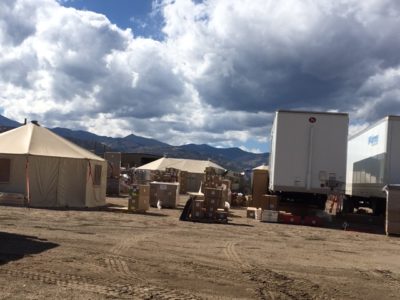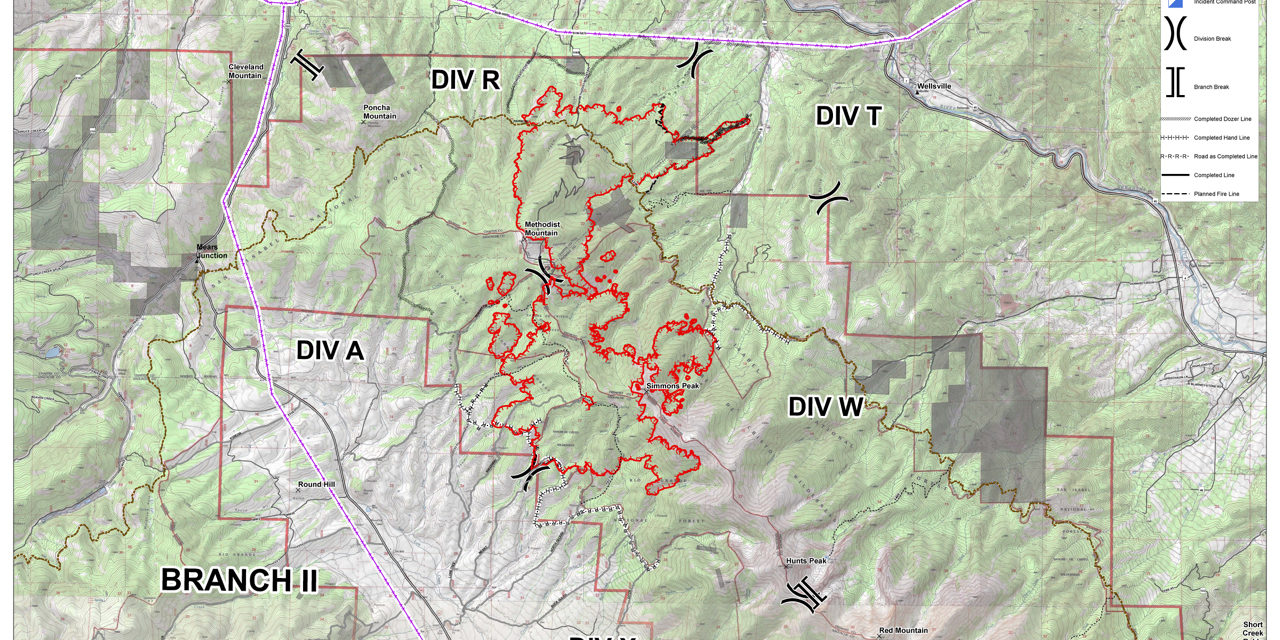Saturday, October 5, with approximately 730 firefighters on the lines of the Decker Fire, and more continue to arrive, the Type 1 Response Team has geared up for a tough fight. The area has been under a Red Flag Warning for extreme wind conditions on Saturday and Sunday. The winds could fan the Decker Fire hovering on the southern edge of Salida, moving it eastward and down-canyon toward Howard.

A public meeting answered Salida resident questions Saturday morning at the SteamPlant.
A Saturday morning public meeting at the SteamPlant saw around 140 people attend, to receive a comprehensive overview of the fire effort.
There are multiple road closures around the Decker Fire area in Chaffee, Fremont and Saguache counties. If an evacuation down-canyon from Salida is ordered, U.S. 50 would be used for evacuations.
“This is a multi-jurisdictional effort. Amateurs talk tactics – professionals talk logistics,” said Type 1 Incident Commander Mark Giacoletto, about the difference a 60-person Type 1 Federal response team represents. “We’re running firefighting operations, a planning division, an entire finance division – the firefighters and resources need to be paid for – and a logistics group. We’ll get close to 900 people once the last of the requested fire fighting crews arrive.”
Fire officials warn of winds by Saturday afternoon coming from the west-northwest at 25 to 35 mph, with gusts over 45 mph. Unofficially, gusts of up to 80 mph have been measured on the mountain on Saturday. Coupled with extremely low humidity, wind conditions blowing embers could create spot fires that can spread quickly.
The fire began Sept. 8 from a lightning strike deep in dangerously steep wilderness terrain in the San Isabel National Forest, some nine miles from Salida. It has been fueled by a heavy fuel load from the beetle-kill forest and downed timber, from a “blow-down” event a few years ago.
Fire crews are working on hand lines and bulldozer teams to create both direct and indirect control lines, tying into natural fire barriers like roads. On the eastern side (the one that could aim down-canyon toward Howard), the fire is near the Continental Divide, and incident command is identifying a route to set an indirect control line.
The south side of the fire was burning in rugged and dangerous terrain and hung up near an old burn scar. Firefighters are going to slowly manage it to burn down to terrain where they can fight it.
The fire now encompasses 5,921 acres and is still only five percent contained. Thursday afternoon, in anticipation of the high winds this weekend that could drive the fire eastward, a pre-evacuation notice was given to the communities of Howard, Pine Ridge, Wellsville and Swissvale. No actual evacuation orders had been given as of Saturday afternoon, and no additional evacuations have been ordered for Salida.
After a relatively quiet Friday in which helicopters could fly and do bucket work, dropping water on the fire, conditions over the weekend are expected to be uncertain. Aircraft will be used for fire fighting today, as long as winds speed will allow them to fly.
Work on Friday to clear the rock slide and reach the communications towers on Methodist Mountain was successful. A team is to be sent up Saturday to check on the towers and their power supply. The towers are needed to maintain cell service and Internet connection in the southern half of Chaffee County. Most have been running on emergency power from propane tanks because the power lines on the mountain have been damaged, as have the highest FM radio towers.

Decker Fire incident command has set up at Chaffee Fairgrounds. By Saturday night, the camp will hold close to 900 firefighters. (Photo by Jan Wondra)
Incident command has defined the fire fighting efforts as a Federal, Type 1 incident, with divisions (R, T, W, and X) grouped into two branches. The southern branch fighting fire on the south to the east side of Methodist Mountain and the northern branch is addressing the fires burning on the west, north and northeast side.
The Incident Base Camp has grown in the past 24 hours into a self-contained tent city. There are massive mobile units housing portable showers, logistics rooms, dining hall areas, stacks of supplies being unloaded, and hundreds of command vehicles from fire companies across the west. A drive into the area as the camp materialized included command trucks with observable license plates from Wyoming, South Dakota, Montana, Kansas, Nebraska, Washington D.C. and many other states.

David Spang, a firefighter in from Lame Deer, Montana, stopped to point out the tent area for his firefighting crew at the Chaffee County Fairgrounds. The Decker fire is his 10th fire this season. (Photo by Jan Wondra)
David Spang, a young firefighter from Lame Deer, Montana (about 30 miles from Coalstrip), stopped for a minute to talk. He pointed out his tent, one of nearly 100, pitched in the antique farm equipment area at the Fairgrounds. He’s had a busy summer. “This is my tenth fire this year,” he said. “And this one is the biggest.”
Firefighting and emergency response managers, forestry officials and the Sheriff’s Department all stressed the need for the public’s patience. The fire was busy cleaning up wilderness fuels for a few weeks before weather conditions forced it out of terrain down where it can be fought.
“My priority is the evacuees,” said Chaffee Sheriff John Spezze. “I know they want to go home. But if we let people back too soon and they have to evacuate again, that is not safe. We need to get through [Saturday’s high winds], then we’ll assess. Our manpower is focused on the roadblocks and escorting evacuees in and out to check on things. We’re doing nighttime patrols of the property too.”
“We needed this fire to get down to where it could be safely engaged,” said Salida Ranger Jim Pitts. He added that even now, the wilderness terrain is difficult and dangerous. “Today, we’re not feeling confident about the weather and hope for the best. When we call in a Type 1 Team, we call it a 7,000 calorie event – just to feed these crews with the effort they are making to fight the fire is incredible.”
Pitts talked about firefighting safety and the danger that fire crews are in. “People have asked what they can do to thank firefighters. Well, the Wildland Fire Fighter Foundation and the Eric Marsh Foundation exist to help wildland firefighters and their families when there is a tragedy.”
Mindful that the terrain is dangerous, a Rapid Extraction Module (REM) has been assigned to the Decker Fire. This is a group of highly trained firefighter-paramedics proficient in high and low angle rope rescue. If a firefighter is injured or incapacitated in difficult-to-access terrain, which is prevalent in the Decker Fire. These rescuers create rope and pulley systems to extract the injured firefighter and get them to a location where a helicopter can land, or an ambulance can access them to get them to a hospital.
“It’s important that people realize the priorities for fighting fires,” said Giacoletto. “First, the highest priority comes the safety of people – firefighters and residents. Then its property, infrastructure and natural resources, in that order.”
Information Center: (719) 626-1095 Hours of operation: 7:30 a.m. – 9:30 p.m.
Website: www.inciweb.nwcg.gov/incident/6592/
Facebook: www.facebook.com/DeckerFire2019/
Email: 2019.Decker@firenet.gov
Twitter: #DeckerFire2019
The Decker Fire is divided into two Branches:
Branch I (on the northeast side by Salida) and Branch II (on the southwest side the San Luis Valley). Then subdivided into five divisions.
Branch I - Salida
• Division T (northeast side by Wellsville)
• Division R (north side by Salida)
• Division W (southeast side by Howard)
• Division A (west side by Poncha Pass)
• Division X (south side by Alder)







Recent Comments